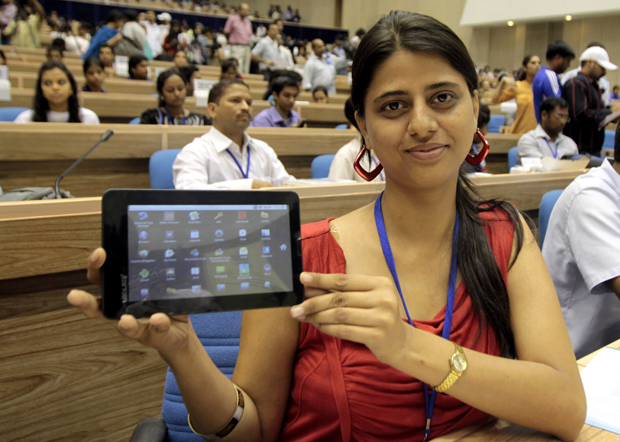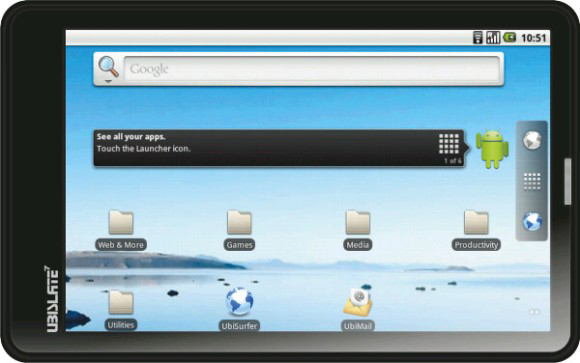Students and professors designed the specs for Aakash, the world's cheapest tablet. Then they handed over their work to a manufacturer. Now they're working on new versions and hope one day soon to have a greater role in how the tech they dream up actually turns out.

Barely a month has passed since the release of India's "$35" Aakash tablet, but its creators already have its successor--a sleeker, more powerful low-cost tablet--ready to launch.
When the Aakash was launched in October, it was greeted with enthusiasm--what potential it holds for a developing market!--followed almost immediately by skepticism--could it possibly work for that cheap? What's the catch?
Aakash, or Ubislate 7 as U.K. manufacturer DataWind calls it, has a 7-inch screen, runs Android 2.2. It comes with a USB drive and microSD slots. Suneet Tuli, cofounder and CEO of DataWind, tells Fast Company that DataWind will follow through with their plans to sell the tablet commercially in India, at the price of Rs. 2,999, about $60 ($35 was actually the price the government paid--read on). Eventually, he hopes they'll sell upgraded versions of the tablet in the U.S. and U.K.

But the original designers of the tablet--students and professors who thought up and prototyped the first early versions of the device--are keeping their sights set squarely on the Indian market, while nurturing more ambitious plans for the next version and making low-cost technology accessible to all Indians.
The first versions of Aakash took shape at the Jodhpur, Rajasthan, campus of the Indian Institute of Technology as part of a government-backed undertaking to bring affordable computers to students in India. Human Resources Development Minister Kapil Sibal, who's been a supporter of science and tech inspired approaches to education before, has been its vocal federal front.
Prem Kumar Kalra, the professor at IIT Kanpur, began engineering the tablet in 2009 with a target price of $50. He brought his work to Jodhpur when he moved to IIT Rajastan to lead the new campus as its director. The Aakash team at IIT is now managed by Kalra, and professors Anupam Gupta and Sandeep Yadav. Together, they advise a band of about 170 students involved in various parts of the still growing project.
The hardware innards of IIT's first version of Aakash exist already, Gupta tells Fast Company. The IIT team picked parts that would meet some basic performance specs, while keeping the overall cost low. The team had a pre-manufacture proof-of-concept of the tablet by August 2010, but the university lacked the ability to mass produce it. Since the Aakash project was a government supported venture, and IIT a government university, they could only offer up the design to commercial manufacturers that met government guidelines. The tech companies could buy and use the design as is or modify it, though, as long as their final product had the necessary features and would sell at the below $50 price.
DataWind bought the design and then created their version of the tablet. According to the IIT team, it lacks the built-in speaker and video conferencing facility that the original design had. But it runs a more advanced version of Android (Froyo, or 2.2).
[youtube tSthJ7HWMNU]
Post-Oct. 5 launch, the first lot of about 500 tablets are still being tested by students. The government of India plans to buy another 100,000 tablets from the company for $35, which they will make available to students at an even lower price or for free.
Meanwhile, the IIT team is moving ahead with more advanced Aakash iterations. Aakash 2 carries “a more capable processor more memory, more onboard storage," Gupta says. It runs Android's Gingerbread OS. As with the first Aakash, the team will need to offer the design to the most appropriate manufacturing bidder. "Our designs are ready. It depends on when the manufacturer is able to take up the order and finish the next one," Gupta says. On Friday, MP Kapil Sibal indicated that the next version may be available as early as February 2012. (Though, Gupta estimates that offering up and finding a bidder for their tender takes a minimum of three months, even before manufacturing begins.)
Though IIT engineers have offloaded a significant amount of their production challenge to manufacturing partners, they continue to stay connected to the project. In the days leading up to the original Aakash launch, students at IIT tested the first few units, identifying and reporting glitches (sometimes with suggested solutions) for DataWind to fix. Sivansh, an electrical engineering major in his fourth year, tells Fast Company they found, for example, that the way DataWind had built the device caused the screen and OS to freeze when a microSD card was inserted into the tablet. After feedback from the IIT students, DataWind changed their design so that this is no longer the case.
Post-pilot launch, one IIT team is working on designing Android apps that will be free to download. Their focus is now on modifying educational apps that will run on the budget device while giving students who use the tablet the kind of access to apps that they’d have on a computer. But they’re also looking further, and are planning apps that are tailored to health care professionals and those in agriculture, lead prof Sandeep Yadav says.
The team leaders are also nurturing innovation on the hardware front. A group of students, Sivansh included, are working on creating a new chip that would be both cheap and powerful. "We think that if we have our own chip, the performance will shoot up and the price will come down drastically," Gupta says. Their goal is for future versions of the tablet will carry this chip, Gupta says.
Missing from equation for IIT is full ownership of its intellectual property--it gives up some of that by farming out manufacturing, and won't share in the commercial gains once Aakash/Ubislate hits the market. IIT director Kalra says he hopes to address the issue of ownership with future devices that are built at the university. They'd like to invite incubators and investors to start backing the do-good tech so they could see it straight through to the market.
"The long-term objective is to create an atmosphere where we don't have any company coming and hiring our students," Kalra says. "They should all become entrepreneurs. That's a goal which we want to set up on a long term." As far as how things are working out with Aakash, he says, it's just the start of many more things to come. "You can't be happy or angry in the beginning. You can just see the sun is rising, that's it."
Nidhi Subbaraman writes about technology and the world. Follow on Twitter, Google+.
[Top, homepage image: Getty Images]